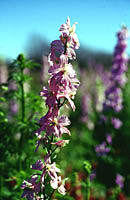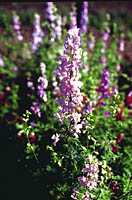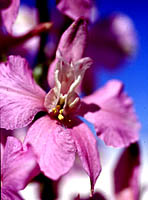LARKSPUR for for the New Millenium
 'Pink Bunny Bloom' Larkspur
'Pink Bunny Bloom' Larkspur 'Blue Bunny Bloom' Larkspur
Bunny-Bloom Larkspur: A reseeding annual with a backward projecting spur and the
head-of-a-bunny formed by the upper white petal of the pink flower. The
can't-miss-it bunny head is pure white framed by pink petals. Tightly compact
blossoms are arranged on spikes. Space transplants 8-10 inches apart. Prefers full
sun to partial shade in very well-drained soils. Do not eat flower or seed!
Larkspur -- February Transplants: Flowering annuals that re-seed and return year
after year can be as valuable as perennial flowers to the garden. There is something
magical about plants that like your garden so well that they choose to come back
each year for another visit. In addition to convenience and economy, reseeding
annuals often add a charm and special character since they
frequently come up in places where we may not have planted them, adding
spontaneity to the garden.
 One of the most spectacular reseeding annuals is larkspur. Larkspur, Consolida
ambigua, is known for its tall spikes of blue, lavender, purple, pink or white flowers.
Bicolor flowers occur occasionally as well. Both single and double flower forms
exist. The double flower has been preferred because of the larger bloom which is
showier in a cutflower or dried arrangement. However, the single flowered version
has a uniqueness and "animal magnetism" which make it much more intriguing than
its bigger blooming sister.
One of the most spectacular reseeding annuals is larkspur. Larkspur, Consolida
ambigua, is known for its tall spikes of blue, lavender, purple, pink or white flowers.
Bicolor flowers occur occasionally as well. Both single and double flower forms
exist. The double flower has been preferred because of the larger bloom which is
showier in a cutflower or dried arrangement. However, the single flowered version
has a uniqueness and "animal magnetism" which make it much more intriguing than
its bigger blooming sister.
How can a flower have animal magnetism? The genus name "Delphinium" comes from the Greek word "delphis," which means "dolphin." To the Greeks the flowers of larkspur, the annual species of delphinium, resembled the shape of a dolphin. If those impetuous Greeks had continued to watch the opening flower bud of the larkspur, anyone with the slightest bit of imagination, and a bit of horticultural wisdom from the great plantsman from San Antonio named John Fanick, can clearly see the flower parts (petals) of a single larkspur form a bunny's head. The color of the petals which form the head shape determines how obvious the bunny head is. Some flowers with pink lower petals (sepals) surrounding white, bunny-head formed center petals dramatically display the hare head.
 The head is not as obvious on flowers which are not bicolor but the shape of
the bunny head remains. As the flower matures, the petals loosen and the bunny head
figure is lost. For several days after blooms open, the bunny head is so exact that
eyes and the curvature of two ears can be detected. If the presence of a cute bunny
head in a flower is not enough to excite you, guess when larkspur blooms in this area.
Easter! Children have always wondered where the Easter bunny lives. Now you can
show them the Easter bunny flower which will be sold as transplants named Bunny
Bloom Larkspur in January - February. You will also demonstrate that you are a
competent plant person by having the spectacular display of Bunny Blooms every
year. Once you plant Bunny Blooms and if you let the Bunnies drop their faces and
mature seed pods, you will be blessed with an abundance of bloom for years -- this
plant multiplies just as the rabbits it displays with such beauty!
The head is not as obvious on flowers which are not bicolor but the shape of
the bunny head remains. As the flower matures, the petals loosen and the bunny head
figure is lost. For several days after blooms open, the bunny head is so exact that
eyes and the curvature of two ears can be detected. If the presence of a cute bunny
head in a flower is not enough to excite you, guess when larkspur blooms in this area.
Easter! Children have always wondered where the Easter bunny lives. Now you can
show them the Easter bunny flower which will be sold as transplants named Bunny
Bloom Larkspur in January - February. You will also demonstrate that you are a
competent plant person by having the spectacular display of Bunny Blooms every
year. Once you plant Bunny Blooms and if you let the Bunnies drop their faces and
mature seed pods, you will be blessed with an abundance of bloom for years -- this
plant multiplies just as the rabbits it displays with such beauty!
A frequent problem with reseeding annuals is over-germination and,
therefore, crowding, to the point that plants cannot grow and produce properly. This
requires careful observation in the garden to check on young seedlings so that when
they reach a size large enough, they can be transplanted or thinned. Most young
seedlings may be successfully transplanted when they put on their second set of
leaves. Some annuals, such as poppies and larkspurs, are somewhat difficult to
transplant and do best when thinned and allowed to mature where they germinated.
Young seedlings of flowering annuals may show little resemblance to the
mature plants and be very difficult to distinguish from weeds. This requires
practice and patience until the young seedlings of desired annuals become familiar.
It also implies that heavy mulches cannot be used in areas where reseeding annuals
are desired. The mulches are just as effective in controlling the desirable annuals as
they are the weeds. The good news is that most pre-emergent herbicides which can
be purchased in garden centers can be used at planting in seeded larkspur areas
without fear of damaging larkspur germination and growth. Other broadleaf weeds
and grasses can be effectively controlled with a chemical pre-emergence herbicide
and larkspur will still thrive.
Although larkspur grow during winter, it takes the warmth of spring to coax them into rapid growth. They reach their full height around Easter in Southcentral Texas. The plants are spectacular, easily grown and make wonderful fresh as well as dried cutflowers. A sunny location and well-drained soil of moderate fertility are the major requirements. Thinning the seedlings in mid-winter or planting transplants 8 to 10 inches apart will usually result in a more impressive display of individual plants that can reach 3 to 5 feet tall. Like poppies and bluebonnets, larkspur usually needs little or no supplemental irrigation, since it completes its life cycle during our naturally cool, moist season. You should try to get your supply of Bunny Bloom larkspur as soon as possible since people are Flipper - ing over this Peter Cottontail of a flower. I recommend planting an entire flat (96 transplants) to ensure a hare - raising visual impact!
I DO NOT recommend this plant for people who like to eat everything in the
landscape since the eating of larkspur seed and young plants can cause more
digestive upset, nervous excitement
and depression than you already have. In fact, the eating of an abundance of larkspur
may be fatal which is probably what you deserve for destroying the natural beauty of
this spectacular reseeding annual!!
After larkspurs have completed their flowering season in late spring, they
may be replaced with hot-season annuals.